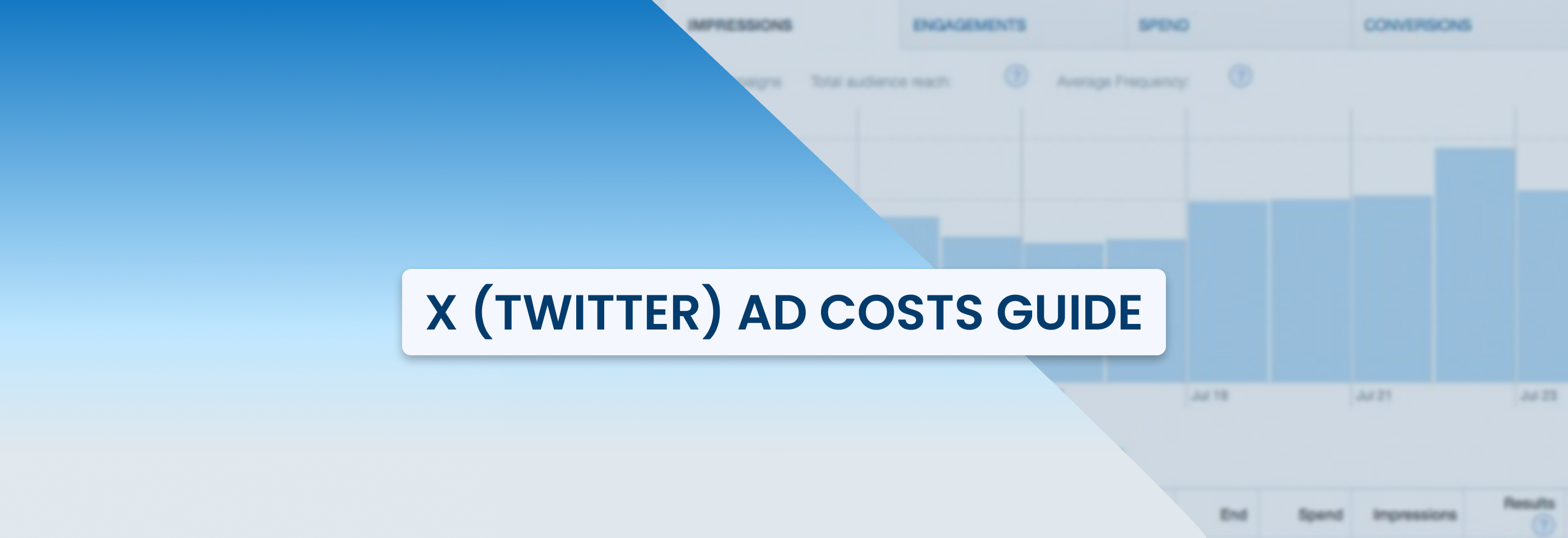YouTube Marketing 101: How to Expand Your Brand’s Reach
2025-03-08

YouTube isn’t just a video platform — it’s a powerful marketing tool that can drive brand awareness, engagement, and sales. But simply uploading videos isn’t enough. To succeed, you need a solid strategy that aligns with YouTube’s algorithm and user behavior.
In this guide, we’ll break down the key elements of YouTube marketing — from the YouTube algorithm basics to how to optimize your channel and create engaging videos.
What is YouTube marketing?
Marketing on YouTube involves using video content to promote your brand, product, or service on the platform. It’s a great chance to increase visibility, help people discover your products, and make an impact on their purchasing decisions.
There are several ways to use YouTube for marketing:
Posting organic content
The foundation of YouTube marketing is creating and sharing original videos. These can include tutorials, product demos, behind-the-scenes footage, or lifestyle content — the key is to be engaging and valuable to your audience.
Nowadays, brands of all sizes are on YouTube — it’s an important marketing tool that you might want to add to your strategy as well.
Influencer marketing
YouTube is one of the most effective platforms for influencer partnerships. In fact, influencer marketing is the most widely used YouTube strategy, according to eMarketer, with organic content coming in a close second. By collaborating with creators who have an established audience, brands can build trust and reach new potential customers in an authentic way.
Running YouTube ads
Paid advertising on YouTube allows brands to reach a wider audience quickly. With various ad formats — like skippable in-stream ads, bumper ads, and display ads — you can target specific demographics and serve the right message at the right time.
Search optimization
YouTube isn’t just a video platform — it’s also the second-largest search engine in the world. That’s why optimizing your content for search is crucial for discovery.
This means strategically using keywords in video titles, descriptions, and tags to improve visibility. However, ranking high isn’t just about keywords — YouTube prioritizes watch time, engagement, and viewer experience.
We’ve already written about YouTube ads before, and for now, we’ll focus on organic YouTube marketing — building a channel, creating engaging content, and optimizing videos for maximum reach.
But first, let’s look at why YouTube has become an essential platform for many businesses.
YouTube marketing: why does your business need it?
First of all, data shows that YouTube is one of, if not the most, popular social media platform not just in the US but worldwide.
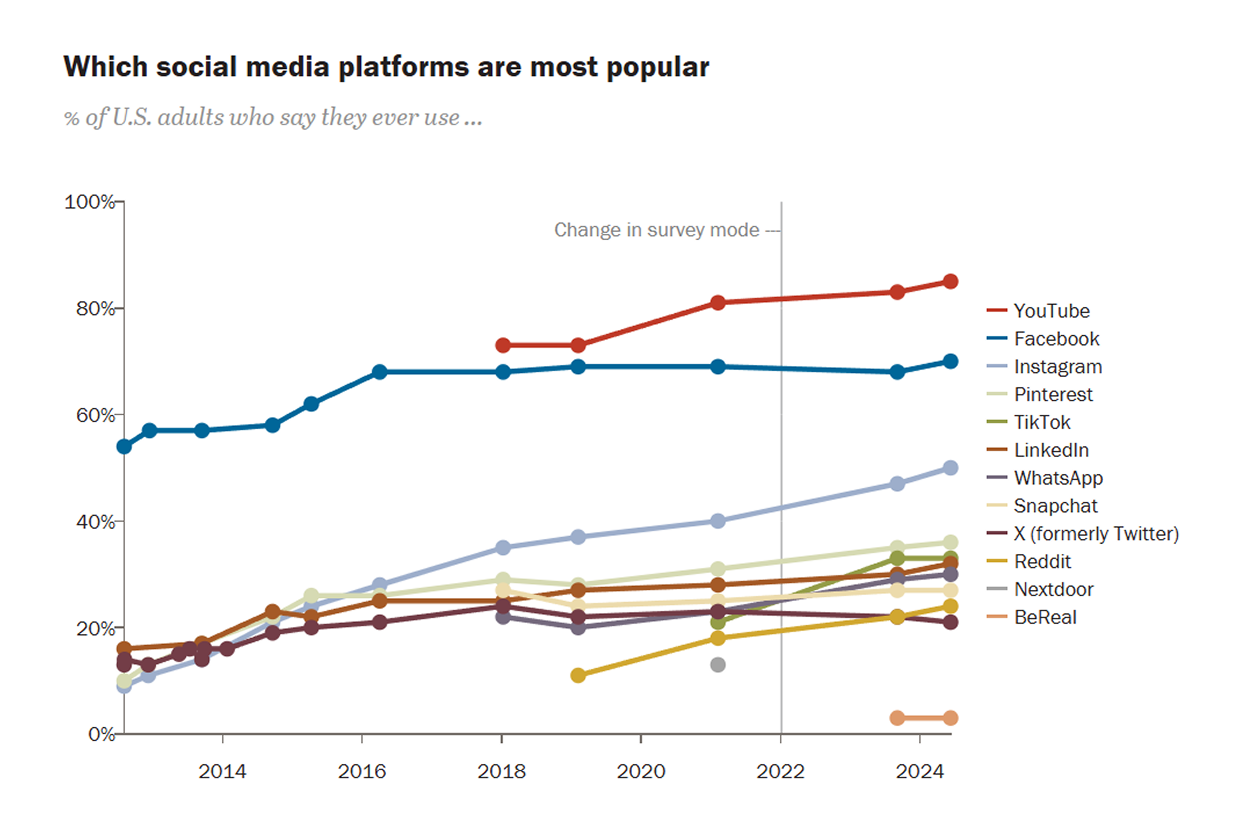
Most popular social media platforms in the US. Source: Pew Research
Other platforms (like TikTok and Instagram) might get the most buzz among marketers, but YouTube still remains users’ favorite with over 2.74 billion active users.
What sets YouTube apart? People spend more time watching videos here than on any other platform. In an era of shrinking attention spans, YouTube continues to hold viewers' interest longer.
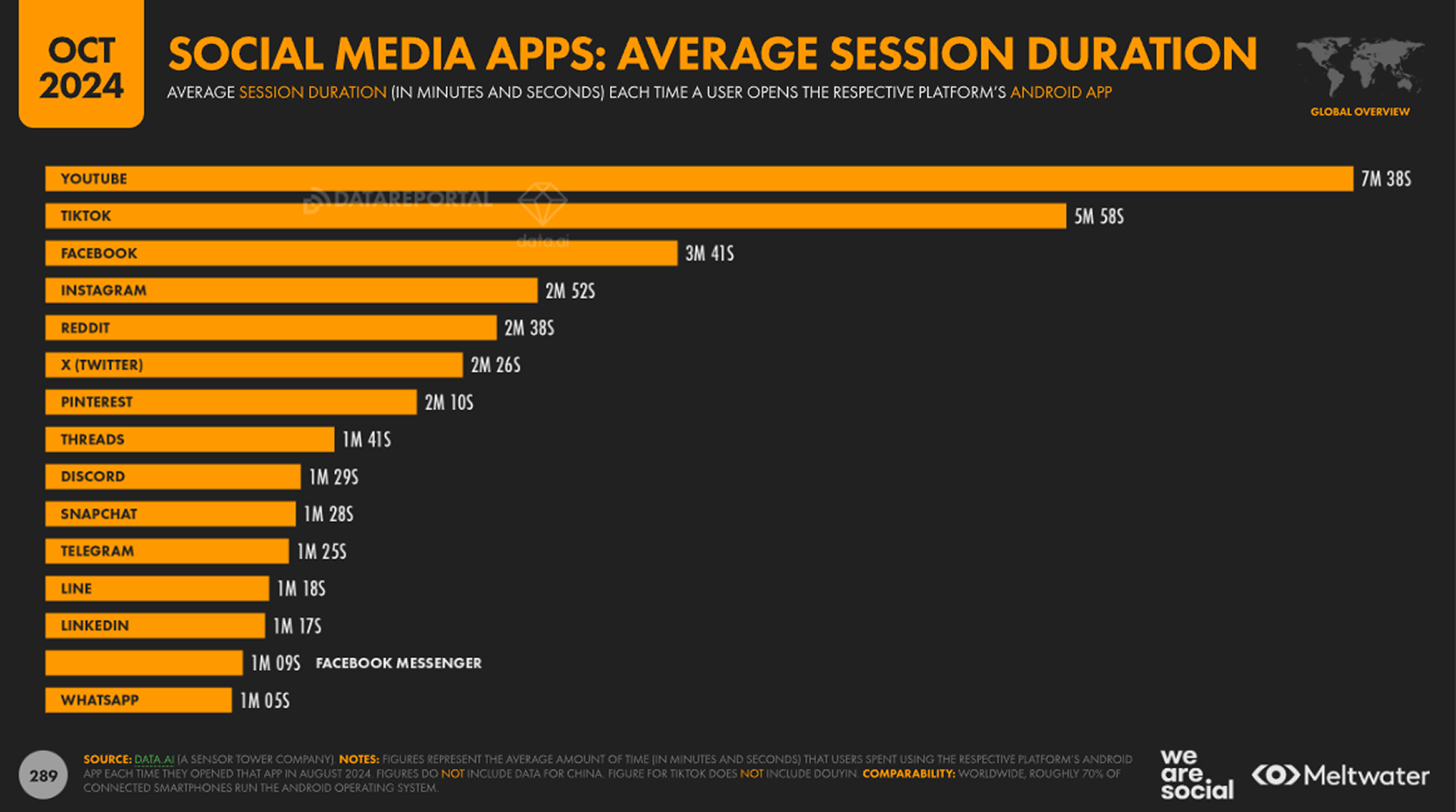
Source: Data AI via Datareportal
What also matters is that over 90% of people discover new brands or products on YouTube, and 68% watch videos that help them make purchase decisions. This means that partnering with the right influencers can help businesses get their products in front of a bigger, more engaged audience.
In short, here’s why a YouTube marketing strategy can be exactly what your business needs:
- Massive reach — available in 100+ countries and 80 languages, YouTube offers unmatched global exposure.
- Stronger brand awareness — tutorials, product demos, and behind-the-scenes videos keep your brand top of mind.
- Improved search visibility — optimized videos rank on both YouTube and Google, driving continuous traffic.
- Higher credibility and trust — people rely on reviews, testimonials, and influencer recommendations before making a purchase.
- Boost in sales and conversions — YouTube videos guide buyers through their decision-making process, turning views into sales.
While YouTube has massive potential, success isn’t just about uploading videos. To maximize results, you need a clear strategy tailored to your audience and a deep understanding of how the YouTube algorithm works.
Let’s dive into how to build a winning YouTube marketing strategy.
How does the YouTube algorithm work?
Many creators and businesses have tried to crack the code, but the YouTube algorithm remains elusive for many. The truth is, there are no hidden secrets – Google is pretty transparent about how everything functions.
Here are the basics:
Viewer behavior shapes recommendations
Instead of just using titles or tags, YouTube personalizes recommendations based on individual user behavior, including:
- Watch history — YouTube tracks the types of videos you’ve watched in the past to predict what you’ll want to see next. If you frequently watch tutorials for a specific topic, YouTube will start recommending similar content even from creators you haven’t subscribed to.
- Engagement patterns (likes, comments, shares) — the more time you spend engaging with a particular topic or creator, the stronger the signal to YouTube that you’re interested in that type of content.
Also, YouTube looks for patterns. If many viewers watch Video A and then Video B, the algorithm assumes a connection between them. This could mean that Video B gets recommended to users who haven’t searched for it.
It’s not just about clicks
Beyond just individual preferences, YouTube also evaluates how a video performs when it’s shown to potential viewers.
When deciding if a video is worth being recommended to more viewers, YouTube looks at metrics like average view duration and average % viewed, both of which affect a video’s rankings. It also checks whether users choose to watch the recommended video or ignore it, and how they behave after watching it, i.e. whether they like it or not.
In short, here’s what matters the most:
- Click-through rate (CTR) — do viewers choose to watch a video when it appears in their feed?
- Watch time and retention — do they stay engaged, or do they leave quickly?
- Engagement signals — do people like, comment under, share, or click "Not Interested" after the video appears in their recommendations?
- Post-watch feedback — YouTube also surveys some viewers to gauge satisfaction, using responses to refine recommendations.
The more engagement a video has (views, comments, shares, likes), the more likely it is to rank higher and appear in more recommendations.
Shorts vs. long-form videos: the difference
The YouTube algorithm treats Shorts and long-form videos differently. Shorts get exposed to a random audience first and, based on performance, are pushed to more people who might find it interesting. In contrast, long-form videos are shown if viewers are actively clicking to watch.
Basically, it’s more about quick engagement and swiping for Shorts, while impressions and click-through rates are more important for long-form content. This means that Shorts are great for immediate impact and engagement, while long-form videos encourage deeper viewer interaction.
However, there’s no ideal video length for ranking — YouTube values content that keeps viewers engaged, whether it’s long or short. The key is to focus on storytelling and audience retention rather than hitting a specific duration.
Keywords still matter
Optimizing video titles, descriptions, and timestamps with relevant keywords helps boost discoverability. However, keywords should align with the content itself. Deceptive tactics like clickbait and keyword stuffing are penalized by YouTube — and viewers don’t appreciate them either.
New channels have higher visibility
New channels often get a visibility boost as YouTube tests their content with audiences. If you’ve just recently created your YouTube channel or are thinking about it, in the initial stages, your videos might get more impressions and views.
However, this boost isn’t permanent — sustainable growth requires consistency. But you can definitely capitalize on this early exposure by posting high-quality, audience-relevant content that delivers your key messages.
Channel growth depends on consistency
YouTube categorizes channels based on consistent content themes. Once you find an audience for a specific content theme, the YouTube algorithm will start promoting your videos to that audience. If you suddenly switch the niche you’re in, you risk losing engagement, which can impact your reach.
So, what’s the final takeaway?
The YouTube algorithm rewards content that resonates with viewers. Instead of trying to game the system, focus on engagement, consistency, and quality storytelling. Aligning your strategy with user behavior and platform trends will naturally improve your performance over time.
How to build an effective YouTube marketing strategy
1. Find your audience
One of the biggest mistakes brands make on YouTube is creating content without a clear audience in mind. Not everyone on YouTube is your customer, so your goal should be to attract and engage the right viewers — those who are most likely to watch, interact, and convert.
You can start by identifying key details about them:
- Age, gender, and location — who is most likely to benefit from your content?
- Language and cultural factors — are you reaching a global audience, or should your content be region-specific?
- Interests and behaviors — what other types of content do they watch? What challenges or questions do they have?
To gather this information, use:
- YouTube Analytics — see who's watching your videos and how they engage.
- Social media insights — identify patterns in your existing audience.
- Competitive research — look at similar channels to see who engages with their content.
- Surveys and social listening – understand what your audience is talking about online.
Once you understand your audience, you can choose the right topics, formats, engagement triggers, and keywords that resonate with them.
2. Organize your YouTube channel
Your YouTube channel is more than just a place to upload videos; it's your brand's online storefront. A well-organized, visually cohesive channel builds credibility, keeps viewers engaged, and boosts discoverability.
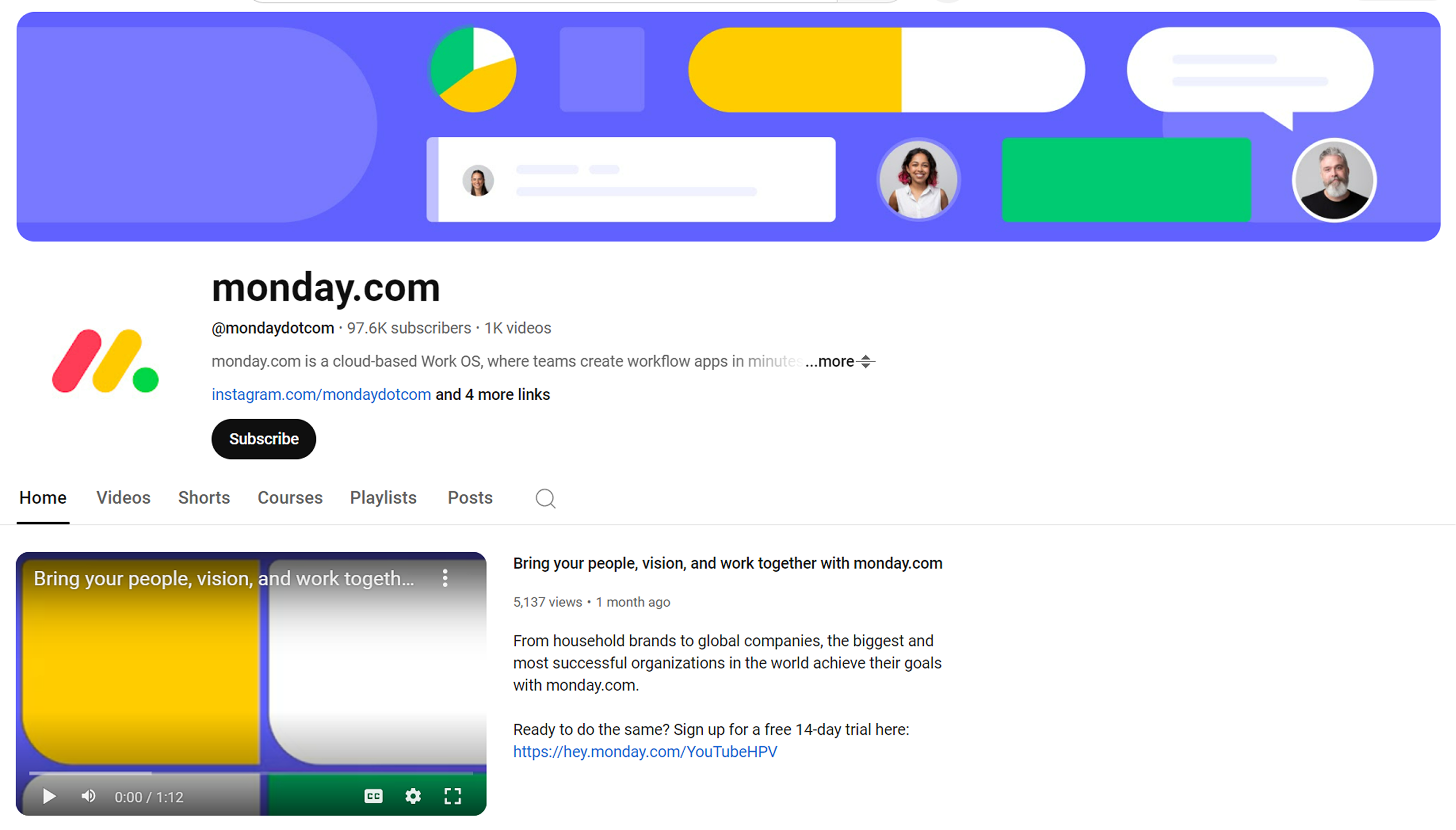
Monday.com has a recognizable look on YouTube: everything (profile pic, banner, and video thumbnails) is matching
So, customize your channel to give it a cohesive, recognizable look:
- Profile picture — use a high-quality logo or an image that represents your brand (800x800 pixels recommended).
- Banner image — add a visually appealing banner that aligns with your brand’s aesthetic (2560 x 1440 pixels).
- Channel description — clearly explain what your content is about and use relevant keywords to boost searchability.
- Social links — add links to your website, store, or other social platforms to drive traffic.
- Custom URL — set up a branded URL to make your channel easy to find and share.
To maintain consistency, create a branded thumbnail template and use similar fonts, colors,and styles across all videos.
Another thing you can do is to create a channel trailer. It’s the first thing new visitors see, so keep it short, engaging, and to the point. Highlight what your channel offers and why people should subscribe.
Also, videos that lead viewers to watch more content (either yours or others’) are favored. You can encourage binge-watching on your channel by using playlists and end screens to keep viewers engaged.
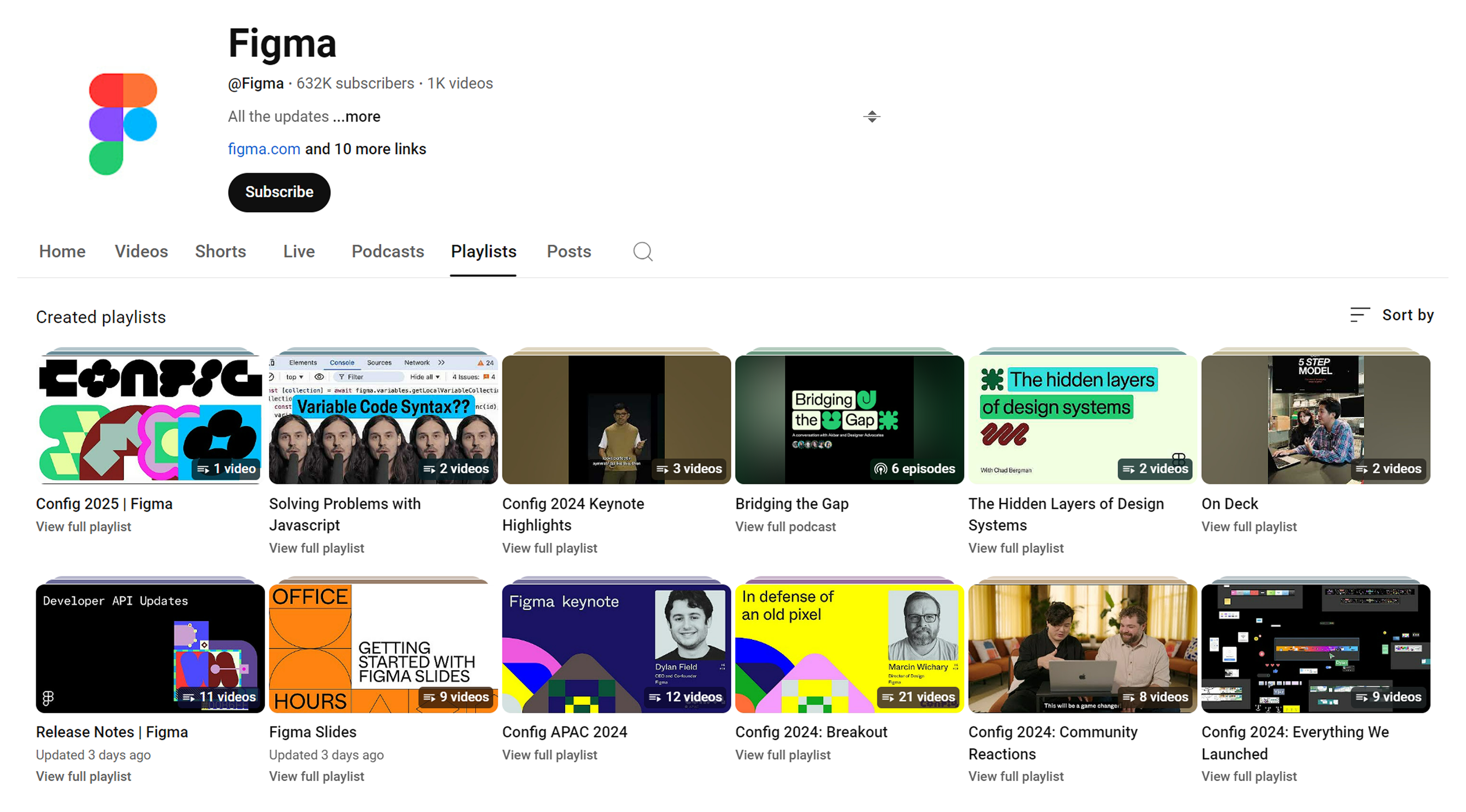
Figma's YouTube videos are neatly organized into various playlists, each with a recognizable cover image
Don’t forget to optimize your channel layout: customize your channel homepage to feature your best content. Arrange playlists, highlight key videos, and add sections that make navigation easy. Prioritize high-performing or introductory videos at the top to capture attention immediately.
3. Create content that keeps people watching
Getting clicks isn’t enough — if viewers don’t stick around, your video won’t perform well. YouTube prioritizes watch time and audience retention, meaning the longer people watch, the more likely your video is to be recommended.
In fact, Sprout Social’s recent report shows that 51% of YouTube users prefer to engage with longer videos from brands (over 60 seconds). So while Shorts are great for quick engagement, long-form content is key for building deeper connections with your audience.
To get good results, you need to make every second count. Pack as much value as possible into each video by covering topics in-depth, remove unnecessary fluff that could cause viewers to drop off, and stay on topic — you want to deliver people exactly what they came for.
To make them stay and watch, you have to hook them in the first 15 seconds: if your intro drags, viewers will leave before they even get to the good part. Start strong by previewing what’s coming up and why it matters instead of wasting time on background information.
A great hook could be:
- A bold statement or surprising fact,
- A quick preview of what’s coming up,
- A direct and relevant question about your audience’s pain points.
Another useful tactic is to use pattern interrupts to keep engagement high. Pattern interrupts like visual or auditory changes help break up monotony and keep attention locked in.
These include:
- On-screen graphics and text overlays to reinforce key points,
- B-roll footage to illustrate what’s being discussed, Different camera angles or zoom effects to add movement,
- Sound effects and music cues to create emphasis.
Adding timestamps can also keep viewers engaged by letting them jump to sections they find most relevant, reducing drop-off rates.
Also, remember that presentation matters too. A messy setup, poor lighting, or bad audio can be distracting enough to drive viewers away.
Here’s what to do instead:
- Declutter your background to keep the focus on you and your message.
- Use good lighting so your video looks professional.
- Invest in a quality microphone — bad audio is a dealbreaker for many viewers.
- Enhance your video with editing — add text, transitions, and graphics to improve visual appeal.
Want your videos to rank on Google? Mention your main keywords naturally while speaking, and add transcripts. This helps search engines understand your content, improving discoverability.
4. Use YouTube Shorts to boost visibility
Long-form YouTube videos are great and all, but Shorts allow you to get more eyes on your content faster. You can use Shorts as a part of your overall YouTube marketing strategy:
- Tease longer videos — post Shorts that highlight key moments from your long-form content to build anticipation and drive traffic to the full video.
- Create standalone Shorts — use them for quick tips, trends, or behind-the-scenes content to keep your audience engaged.
- Build hype for product launches — a series of Shorts can create buzz before dropping a detailed product video.
To improve watchability, enable automatic captions for accessibility and add end screens to guide viewers to more of your content.
Need inspiration for your videos? YouTube’s Inspiration Tab (an AI-powered tool) can help generate fresh ideas, titles, and thumbnails — just refine the prompts to match your brand’s style.
And since most YouTube users watch on mobile, optimize your Shorts for vertical viewing to ensure the best experience.
5. Use click-worthy titles and descriptions
Titles and descriptions can be your gateway to getting more YouTube views. They help your video show up in search results, grab attention, and keep viewers watching.
Your video title should be short and easy to understand. Try to keep it between 40-50 characters and include the most important keywords.
There are two great strategies you can try: making your video titles searchable or intriguing. A searchable title makes it clear what the video is about, which helps it end up in the “suggested” category. An intriguing title, on the other hand, makes people curious about the video’s content — it can reach users who weren’t looking for videos on this particular topic.
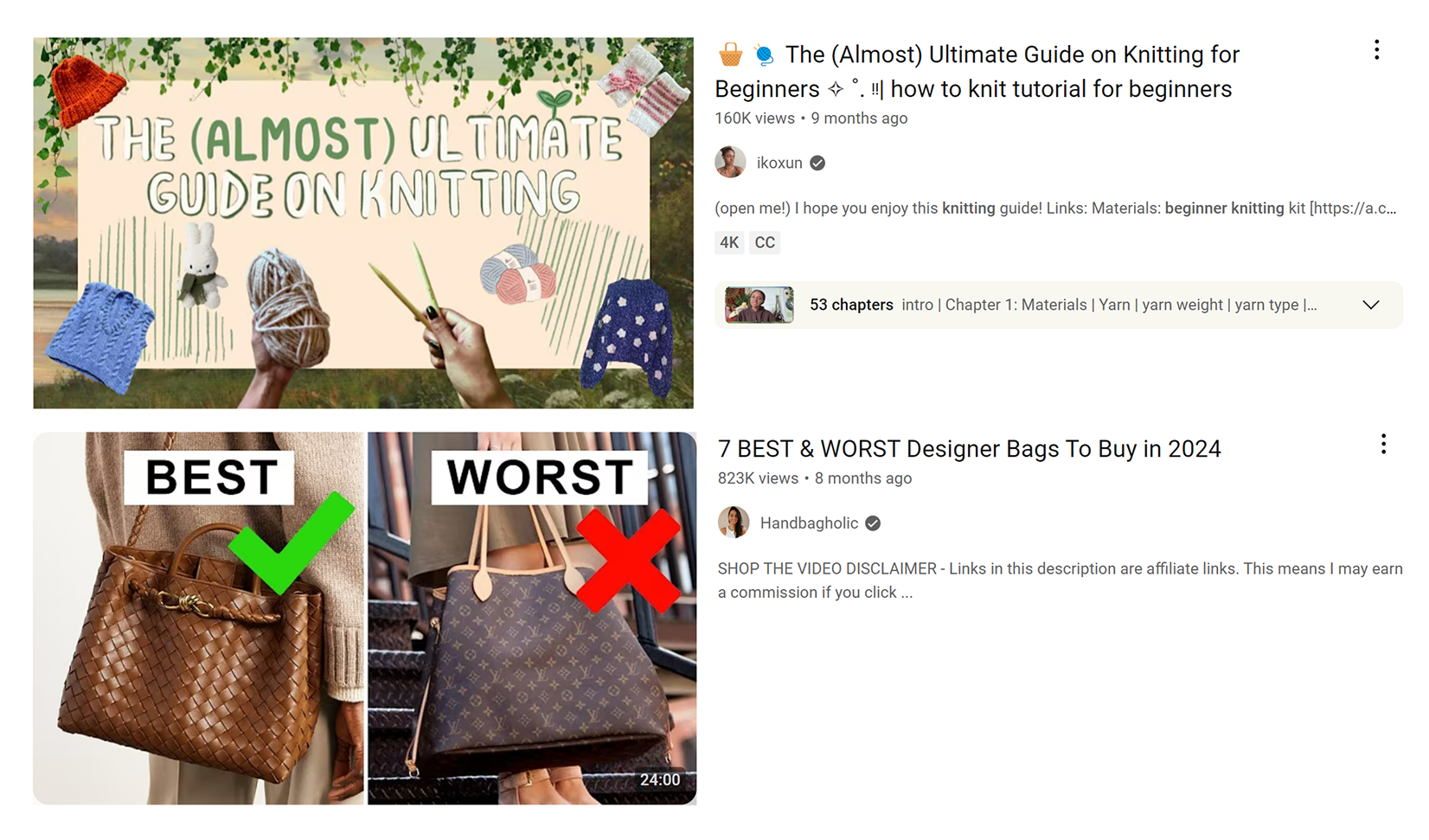
There are many ways to catch attention with your YouTube titles — the key is to bring relevant audiences to your videos
Pro tip: add brackets, numbers, or emojis to make titles stand out. For example, “5-Step Guide to YouTube SEO [New Checklist]” is far more engaging than just “YouTube SEO Tips”.
When it comes to video description, it should be detailed but concise. Describe what your video is about in at least 150 words — this will help viewers know what to expect.
Even though there’s data showing that keywords in descriptions don’t directly impact YouTube rankings, it doesn’t mean you should forget about them. They help YouTube understand your content and show it as “suggested”, so add relevant keywords in your description as well.

If you type any keyword into YouTube's search bar, you'll see that the videos shown all have the same or related keywords in their descriptions
If you want to reach a global audience, translate your video title and description into multiple languages to make your content more accessible to viewers worldwide.
Also, link to your website, social media, or other related videos in the description or in the pinned comment, and ask viewers to like, comment, and subscribe.
6. Design attention-grabbing thumbnails
Your video thumbnail is the first thing people see, so making it stand out is key. In fact, YouTube reports that 90% of top-performing videos have custom thumbnails — they’re made to fit what the channel and the video are about, as well as what the intended audience is looking for.

Under Armour uses neat color contrasts in their YouTube thumbnails, creating a fresh, eye-catching look
Here’s what makes a great youtube thumbnail:
- Bold, contrasting colors — avoid colors that blend together. Use bright, high-contrast combinations to grab attention.
- BOGY colors (Blue, Orange, Green, Yellow) — these colors contrast well with YouTube’s red, white, and black theme, making your thumbnails pop.
- Clear, large text — use simple, readable fonts with a strong outline for clarity.
- Facial expressions — if featuring a person, use expressive close-ups to convey emotion and curiosity.
- Minimal clutter — keep it simple. Too much text or detail can make your thumbnail look messy and less engaging.
A well-optimized title, description, and thumbnail work together to increase visibility and clicks, giving your video the best chance of success.
7. Stick to a posting rhythm
One of the biggest factors in YouTube success is consistency. Viewers like knowing when to expect new content, and the YouTube algorithm rewards channels that post regularly.
You can post one video per week, per month, etc. — the right frequency depends on your niche, audience, and how much content you can realistically create.
Do this to stay on track:
- Use a content calendar — plan your videos in advance to avoid last-minute stress and maintain a steady flow of content. Tip: Post Shorts between longer videos to stay active.
- Schedule posts in advance — use content management tools to schedule videos ahead of time to never miss a deadline.
- Tell your audience — If you upload every Tuesday, for example, make that clear in your channel banner, descriptions, or even at the end of your videos to build anticipation.
- Check your analytics — use YouTube Analytics to track engagement and adjust your posting schedule based on when your audience is most active.
A steady posting schedule will help you build loyal viewers and improve your chances of getting recommended by YouTube.
8. Use YouTube Shopping to sell your products
If you're making videos to promote your brand, why not make it easy for people to shop while they watch? YouTube Shopping lets you show products right on your channel so viewers can buy without leaving YouTube.
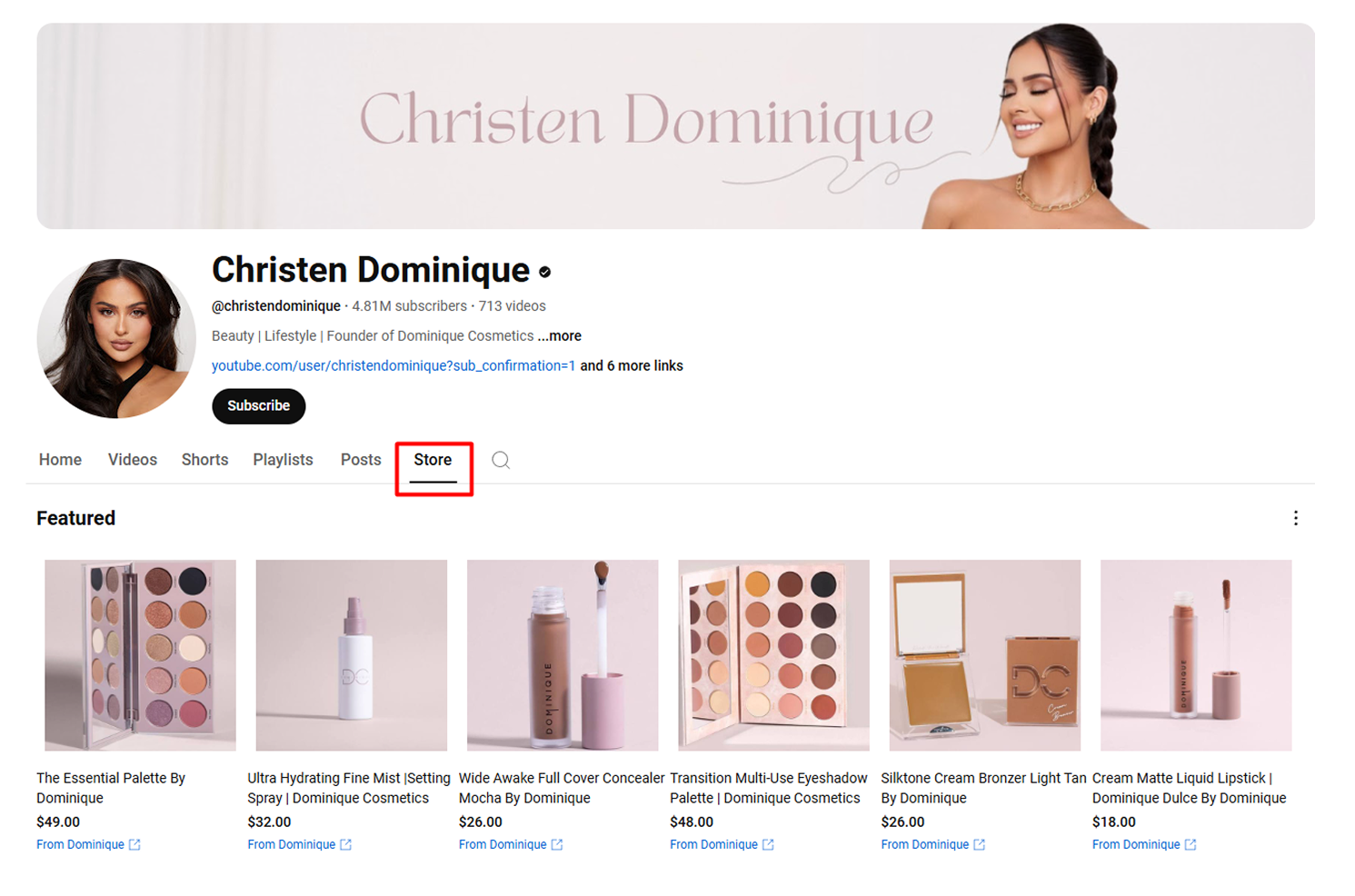
Here’s how to do it:
- Connect your store to YouTube to feature your products in videos, Shorts, and live streams.
- Tag products mentioned in your videos — if you mention or show a product, tag it so viewers can buy it easily.
- Use the product shelf and Shopping button — these let you show your products under your videos and on your channel’s store tab.
- Add product links in descriptions — this gives viewers another simple way to shop.
By making your channel shoppable, you help turn viewers into customers with just a few taps. By the way, you can track how well your products are selling with YouTube Shopping Analytics.
9. Check YouTube analytics
Want to know what’s working on your channel? YouTube Analytics will give you all the answers: it shows which videos perform best, how people find your content, and what keeps viewers watching.
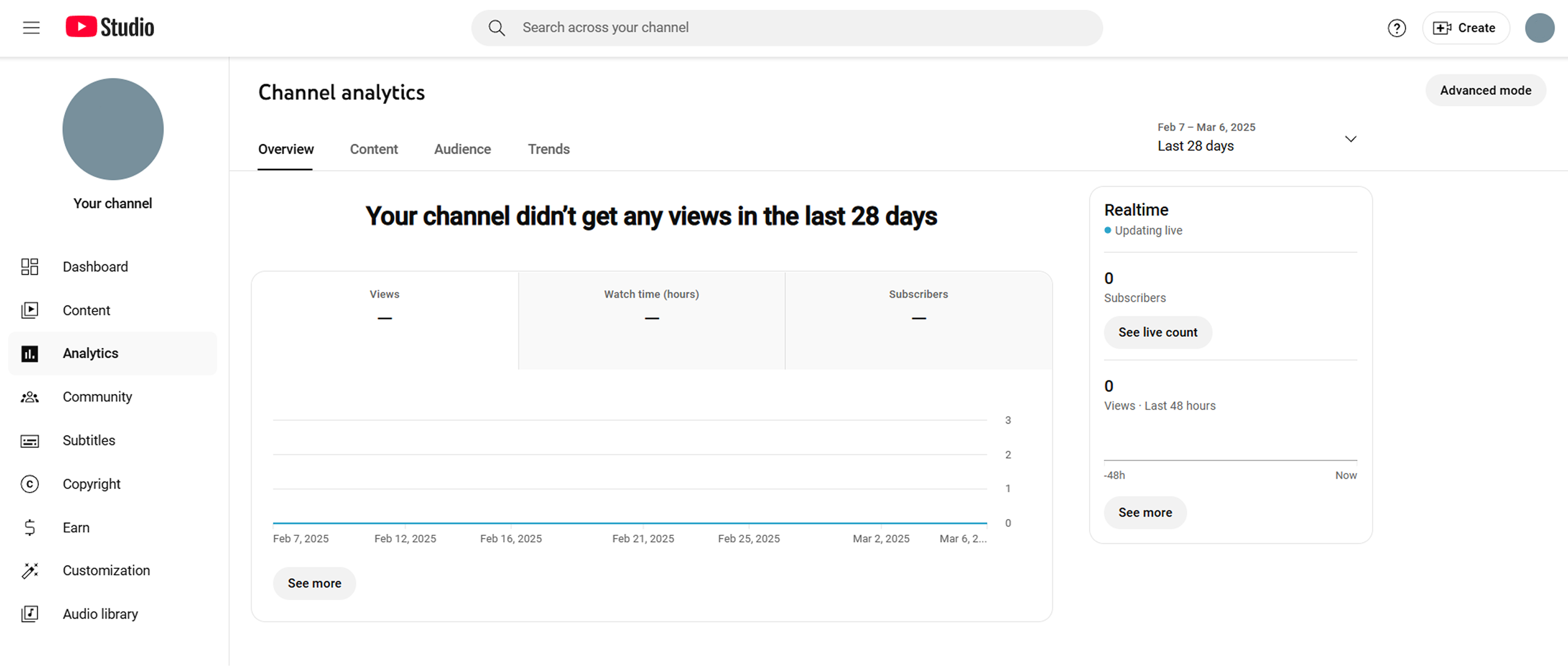
At first, your YouTube analytics might look like this. But don't worry — once you find your audience and start posting, you'll see your metrics changing for the better
To access it, head to YouTube Creator Studio and look at these key insights:
- Views and watch time — see how many people are watching and how long they stay. More watch time = better engagement.
- Audience retention — find out where viewers lose interest so you can improve future videos.
- Subscribers and growth — learn which videos bring in the most new subscribers. Traffic sources — discover how people find your content (search, suggested videos, social media, etc.).
- Audience demographics — see who’s watching your channel to create content they’ll love.
Checking your analytics regularly helps you post smarter, create better videos, and grow your YouTube channel faster.
Recap
YouTube marketing isn’t just about making videos — it’s about strategy, consistency, and knowing your audience. By optimizing your content, using engaging formats, and taking advantage of YouTube’s features, you can grow your reach and turn casual viewers into customers.

